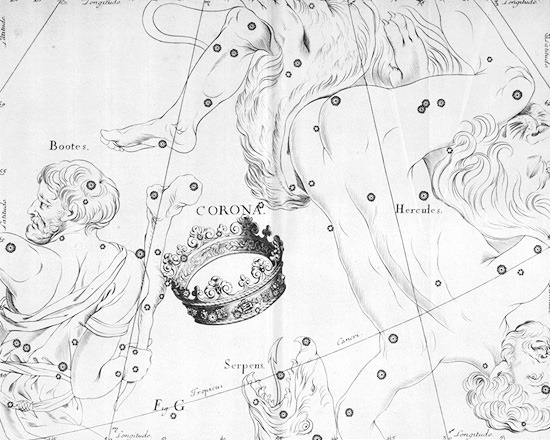A Medieval Manuscript Likely Hides a Record of an Impending Recurrent Nova
By Jon Voisey
Approximately every 80 years, a faint 10th magnitude star in the constellation of Corona Borealis dramatically increases its brightness. This star, T CrB, is known as a recurrent nova and last flared in 1946, peaking at magnitude 2.0, temporarily making it one of the 50 brightest stars in the night sky.
Aside from the 1946 eruption, the only other confirmed observation of this star’s outburst was in 1866. But new research by Dr. Bradley Schaefer suggests that a medieval monk may have spied T CrB brightening in 1217.
In medieval monasteries, monks would regularly keep chronicles – a list of notable events that happened throughout the year. In 1217, the abbot of Ursberg Abbey (in southern Germany, west of Augsberg) was Burchard. In the chronicle for that year, he wrote:
In the autumn season of [1217], in the early evening, a wonderful sign was seen in a certain star in the west. This star was located a little west of south, in what astrologers call Ariadne’s Crown [Corona Borealis]. As we ourselves have observed, it was originally a faint star that, for a time, shone with great light, and then returned to its original faintness. There was also a very bright ray reaching up the sky, like a large tall beam. This was seen for many days that autumn
But was this “wonderful sign” a nova, or one of many other types of transient events that could grace the night sky?
Schaefer first rules out the possibility that the event could have been a supernova, as any supernova visible to the naked eye and that recent would leave an easily detectable remnant. For example, the remnant associated with a supernova in 1054 is the Crab Nebula, easily visible with even small telescopes. Several older supernovae also have remnants associated with them (although sometimes the identification is uncertain, as the historical record was not sufficiently precise on the location in the sky of the object). Since no such remnant is found in this region of the sky, Schaefer concludes that the eruption must not have been particularly destructive.
Similarly, Schaefer deems a supernova unlikely, as such an event would have been visible for several weeks. However, Burchard describes it as only being visible for “many days” which is more in line with T CrB’s average visibility of about 7 days.
But was the observation a misidentification of a bright planet? Also impossible, as Corona Borealis is 45º away from the ecliptic and no naked-eye planet strays that far from this plane of the solar system.
Perhaps a comet? This hypothesis has some merit, as comets are more frequent than such novae. Another chronicle from Saint Stephani monastery describes a possible comet in the same year, but does not give any indication as to what season or where in the sky.
Even the notion that this other chronicle did describe a comet is in doubt, as the terminology used is vague. The author described it as a “stella comes” where “comes” is generally used as a title for a Count, although there is another instance in the same chronicle where the same phrase is used to describe another transient event in 1208, associating it with an ill omen. Rather, comets were generally described as a “tailed star,” “torch-like star,” or a “star of death.” Thus, the language used is ambiguous at best.
Another argument against the cometary hypothesis is the association of a positive omen with this star’s appearance. Historically, comets were taken as negative omens, associated with death and the fall of kingdoms.
Schaefer also discusses a possible sighting of T CrB in 1787. This potential sighting comes from a catalog of stars published in 1789 by the English astronomer Francis Wollaston. In it, Wollaston lists a star near the coordinates for T CrB. While he doesn’t specify a magnitude, the catalog has a limiting magnitude of 7.8 – meaning that, if the star was indeed T CrB, it must have been observed during an eruption.
Could Wollaston have made an error? Possibly, but unlikely, Schaefer concludes. Wollaston did incorrectly identify the star as one from a catalog by William Herschel: V 75. However, Herschel described this star as being part of an arc of three stars and 1º from ? CrB. This description does not match well with Wollaston’s coordinates and most likely describes the star HD 143707. Indeed, there are no other stars of a similar magnitude within the error range described by Wollston.

Again, Schaefer considers and discounts other possibilities. He rejects a comet as unlikely, as Wollaston was a trained observer who was familiar with comets. Asteroids so far from the ecliptic could never be so bright. A recent supernova would remain a bright X-ray source to this day. An error in the measurement of another star giving such precise coordinates for the location for T CrB Schaefer estimates at approximately 8.5 in 10 million. Faced with no viable alternative, Schaefer concludes that Wollaston likely caught T CrB at the end of an eruption, recorded its position accurately, and misidentified it as star V 75 from Herschel’s catalog.
As for the next eruption of T CrB, the star recently began dropping in brightness, which was observed to happen in 1945 approximately 8 months prior to its eruption. If this behavior repeats itself again, Schaefer predicts the star should brighten again in the early spring of 2024, becoming the brightest nova since CP Puppis erupted in 1942.
Dr. Schaefer will be giving a webinar in conjunction with the AAVSO Saturday, September 9, 2023 at 1pm CST regarding his research on T CrB.
The post A Medieval Manuscript Likely Hides a Record of an Impending Recurrent Nova appeared first on Universe Today.

September 9, 2023 at 12:12AM
via Universe Today read more...

Post a Comment